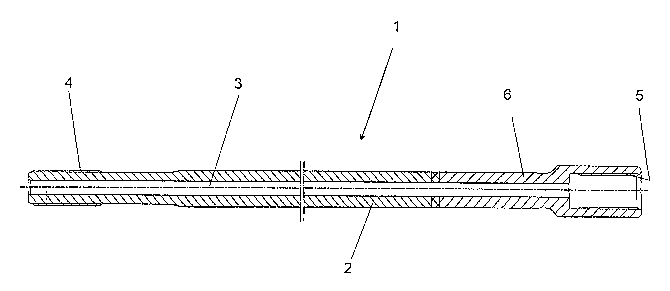Some of the information on this Web page has been provided by external sources. The Government of Canada is not responsible for the accuracy, reliability or currency of the information supplied by external sources. Users wishing to rely upon this information should consult directly with the source of the information. Content provided by external sources is not subject to official languages, privacy and accessibility requirements.
Any discrepancies in the text and image of the Claims and Abstract are due to differing posting times. Text of the Claims and Abstract are posted:
| (12) Patent Application: | (11) CA 2525718 |
|---|---|
| (54) English Title: | A CONNECTION ROD FOR ROCK DRILLING AND A METHOD OF PRODUCING THE SAME |
| (54) French Title: | BARRE DE LIAISON UTILISEE POUR LE FORAGE DE ROCHES, ET SON PROCEDE DE PRODUCTION |
| Status: | Deemed Abandoned and Beyond the Period of Reinstatement - Pending Response to Notice of Disregarded Communication |
| (51) International Patent Classification (IPC): |
|
|---|---|
| (72) Inventors : |
|
| (73) Owners : |
|
| (71) Applicants : |
|
| (74) Agent: | KIRBY EADES GALE BAKER |
| (74) Associate agent: | |
| (45) Issued: | |
| (86) PCT Filing Date: | 2004-04-28 |
| (87) Open to Public Inspection: | 2004-11-25 |
| Availability of licence: | N/A |
| Dedicated to the Public: | N/A |
| (25) Language of filing: | English |
| Patent Cooperation Treaty (PCT): | Yes |
|---|---|
| (86) PCT Filing Number: | PCT/SE2004/000655 |
| (87) International Publication Number: | WO 2004101948 |
| (85) National Entry: | 2005-11-14 |
| (30) Application Priority Data: | ||||||
|---|---|---|---|---|---|---|
|
The present invention relates to a connection rod (1) for rock drilling
comprising a first rod part (2) which has an external thread (4) provided at
one end thereof, wherein the end of the rod opposite to said one end includes
an end portion (6) which carries an internal thread (5), wherein the end
portion (6) is joined to the first rod part (2) by friction welding and
wherein the end portion (6) has been heat treated prior to being joined to
said first rod part (2). The invention also relates to a method of producing
such a connection rod.
L'invention concerne une barre de liaison (1) utilisée pour le forage de roches. Cette barre de liaison comprend une première partie de barre (2) pourvue d'un filet externe (4) au niveau d'une extrémité. L'extrémité de la barre située à l'opposé de cette extrémité comprend une partie terminale (6) pourvue d'un filet interne (5). Selon l'invention, cette partie terminale (6) est unie à ladite première partie de barre (2), par soudage par friction, ladite partie terminale (6) étant soumise à un traitement thermique avant d'être unie à la première partie de barre (2). Cette invention se rapporte en outre à un procédé de production de ladite barre de liaison.
Note: Claims are shown in the official language in which they were submitted.
Note: Descriptions are shown in the official language in which they were submitted.

2024-08-01:As part of the Next Generation Patents (NGP) transition, the Canadian Patents Database (CPD) now contains a more detailed Event History, which replicates the Event Log of our new back-office solution.
Please note that "Inactive:" events refers to events no longer in use in our new back-office solution.
For a clearer understanding of the status of the application/patent presented on this page, the site Disclaimer , as well as the definitions for Patent , Event History , Maintenance Fee and Payment History should be consulted.
| Description | Date |
|---|---|
| Application Not Reinstated by Deadline | 2010-04-28 |
| Time Limit for Reversal Expired | 2010-04-28 |
| Inactive: Abandon-RFE+Late fee unpaid-Correspondence sent | 2009-04-28 |
| Deemed Abandoned - Failure to Respond to Maintenance Fee Notice | 2009-04-28 |
| Inactive: IPRP received | 2007-06-13 |
| Letter Sent | 2006-03-30 |
| Inactive: Single transfer | 2006-02-27 |
| Inactive: Courtesy letter - Evidence | 2006-01-31 |
| Inactive: Cover page published | 2006-01-26 |
| Inactive: Notice - National entry - No RFE | 2006-01-24 |
| Application Received - PCT | 2005-12-14 |
| National Entry Requirements Determined Compliant | 2005-11-14 |
| National Entry Requirements Determined Compliant | 2005-11-14 |
| Application Published (Open to Public Inspection) | 2004-11-25 |
| Abandonment Date | Reason | Reinstatement Date |
|---|---|---|
| 2009-04-28 |
The last payment was received on 2008-03-12
Note : If the full payment has not been received on or before the date indicated, a further fee may be required which may be one of the following
Please refer to the CIPO Patent Fees web page to see all current fee amounts.
| Fee Type | Anniversary Year | Due Date | Paid Date |
|---|---|---|---|
| Registration of a document | 2005-11-14 | ||
| Basic national fee - standard | 2005-11-14 | ||
| MF (application, 2nd anniv.) - standard | 02 | 2006-04-28 | 2006-03-29 |
| MF (application, 3rd anniv.) - standard | 03 | 2007-04-30 | 2007-04-04 |
| MF (application, 4th anniv.) - standard | 04 | 2008-04-28 | 2008-03-12 |
Note: Records showing the ownership history in alphabetical order.
| Current Owners on Record |
|---|
| ATLAS COPCO SECOROC AB |
| Past Owners on Record |
|---|
| LEIF NORDFELDT |